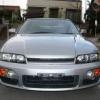Fibreglass Corner Gauge Pods - R33
Announcements
-
Similar Content
-
Latest Posts
-
To back this up, I'm always looking on the outside, seeing the level, and then opening it up anyway, as I'm worried the level I've looked at, is more so a scunge line. Then you end up dipping your damn finger in it too depending on the type of tank you're looking at just to make sure I'm not going insane. PS, Mark, polish up the none moroso one a bit and then give it a clear coat. The Moroso one looks to be way shiner (not mirror polished, just shinier) and it'll still look weird with the two different alloys beside each other. Either that, or Id probably paint them a flat black...
-
Good old Orange Park hey... 😛 f**k I miss that race track
-
lo, it was a death trap. Good times. Got any Fatz Drift Day DVDs still available?
-
Yes, overthinking. Many PS reserviors are completely opaque. Our Skyline ones, for example. Have to remove lid, peak inside, swirl the dipstick, try to remember how to read it, etc etc. Normal. Radiator overflows are often sufficiently opaque and scunged up that you can't see the true level inside anyway, and have to open and have a peak. Besides which, I replaced the (massively expensive, even back then) plastic overflow in my Alfa GTV, back in the '90s with a stainless one that I had a good fabricator make up to be dimensionally same-same, that looks remarkably similar to the Bogan's Moroso one above, and I never suffered any particular paranoia that I didn't know how much coolant was in it.
-
By soviet_merlin · Posted
Looks great, but I'm always concerned that it makes it difficult to see what level the fluids are at. Am I overthinking this?
-







Recommended Posts